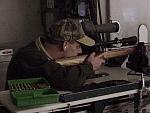Actually - no they don't. Thanks for proving my point about ignorant individuals spreading bad information though.
1. I've toured the factory
2. I've built my own rifle in the factory
3. I'm in direct contract with people at all levels at Savage - engineers, customer service, quality control, sales & marketing, etc.
4. I've asked several of those folks this very question, and EVERY TIME the answer has been the same.
Do you see a tube or tub of anti-seize at this work station? Nope - because their wasn't any.
Attachment 3115
Attachment 3116
Attachment 3117
The gal in the photos above is one of the "swingers" at Savage, the name of the position of those who mate the barrels to the actions. The first photo shows the barrel clamped in a pneumatic vise where the nut is screwed on, then the action is screwed on, the headspace is set and the nut is torqued to spec. The second photo shows the barreled action in a cradle with a mic measuring runout on the barrel. The ram is used to tweak the fit of the action to the barrel to eliminate any runout. The last photo is Fred (sharpshooter) headspacing the barrel on the rifle he built while we were there in the same pneumatic vise that's shown in the first photo.
And this last photo is of me shooting the rifle I built that day in Savage's indoor R&D range.

Now tell us again how Savage uses anti-seize on their barrel threads...





 Reply With Quote
Reply With Quote





Bookmarks